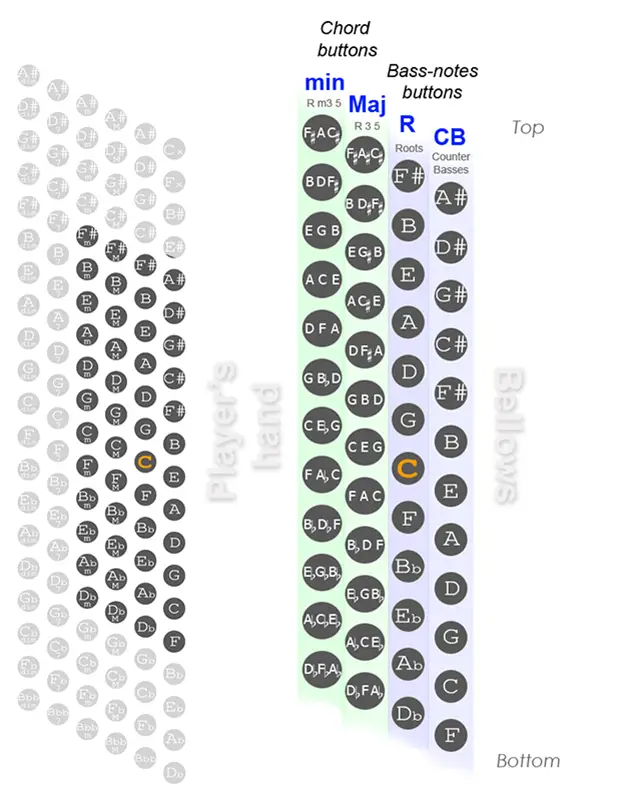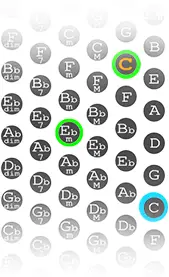The 48 bass (12×4) layout has 2 columns of single bass notes (roots and counter basses), 2 columns of chords (Major, minor), and 12 rows. Compared to the smaller model (the 40 bass layout), it can’t play Dominant 7th nor diminished chords but it has a complete set of bass keys. The other 48 bass accordion model, the 8×6 layout, has 2 extra columns of chords (Dominant 7th and diminished 7th) but it doesn’t have a full set of keys as the 12×4 layout. The 48 bass accordion is considered a good instrument for beginners because it’s small, light, and easy to hold.
If you are totally new to the Stradella bass system, read this article.
48 (12×4) Bass Accordion Layout

All chords you can play on a 48 (12×4) Bass Accordion
There are two columns of standard chords:
- 12 major chords
- 12 minor chords
in all keys, however, combining chords and roots (or counter basses) you can get:
- 10 Dominant 11th chords
- 10 Dominant 9th sus4 chords
- 11 Dominant 9th chords
- 11 Major 7th/9th chords
- 11 minor(Major 9th) chords
- 11 minor 9th chords
- 12 minor 7th chords
- 12 Half-diminished chords
- 16 Major 6th chords
- 16 Major 7th chords
When a chord family has 12 chords it means that you can play that kind of chord in all keys.
If a chord family has less than 12 chords it means that some keys are missing.
How to read the lists of chords
Here are some guidelines to help you read the following lists of chords and charts:
- Flats and sharps are paired with their enharmonic equivalent chord, for example, C#Maj7 = DbMaj7
- Chords that can be played are clickable and are colored in dark red, for example, DMaj
- Chords that can’t be played are colored in gray and are crossed out by a horizontal line, for example,
Bdim7. - Duplicated chords are colored in light blue, for example, E#m7 = Fm7
- Some chords can be played in two different ways:
-
- by combining a chord with a bass note or
- by combining a chord with a counter-bass button.

The charts of those extended chords that can be built combining a chord with a counter bass or with a bass note, show both positions: counter basses are circled in blue, and basses are circled in green.
Usually, the green pattern is the most common and convenient. However, in some cases, it could be easier to play the root on the counter bass column.
For this reason, you’ll find two lists for the same group of chords, one for those that can be played combining a counter bass with a chord (“On Counter Bass” list) and one for those chords that can be played combining a bass note (“On Root” list).
Standard chords
12 Major chords
Major chords are built with a Root (R), a major third (3rd), and a perfect fifth (5th).
On a 48 bass accordion (12×4 layout) you can play these Major chords:
- F#Maj = GbMaj
- BMaj
- EMaj
- AMaj
- DMaj
- GMaj
- CMaj
- FMaj
- BbMaj = A#Maj
- EbMaj = D#Maj
- AbMaj = G#Maj
- DbMaj = C#Maj
12 Minor chords
Minor chords are built with a Root (R), a minor third (m3rd), and a perfect fifth (5th).
On a 48 bass accordion (12×4 layout) you can play these minor chords:
Combined Chords
10 Dominant 11th chords
The Dominant 11th chord is a dominant 7th chord with a major 9th (same as a 2nd) and an 11th (same as a 4th) added.
It is built with a Root (R), a major third (3rd), a perfect fifth (5th), a minor 7th (m7th), a major ninth (9th), and an eleventh (11th).
On the accordion, you can play a Dominant 11th chord by combining a Root and its major chord with the major chord built on its minor 7th interval, for example, C + CMaj + BbMaj = C11.
The 11th interval is dissonant in major and dominant chords because the 11th and the major 3rd are adjacent tones.
For example, C11 = C, E, G, Bb, D, F.
On a 48 bass accordion (12×4 layout) you can play these Dominant 11th chords:
10 Dominant 9th sus4 chords
Dominant seventh ninth suspended chords (9sus4) consist of a Root (R), no third, a perfect fourth (4th), no fifth, a minor seventh (m7th), and a ninth (9th) note of the major scale built on the root.
Stradella bass system allows you to play 9sus4 chords on the accordion combining the root bass with the major chord of its minor 7th degree, for example, C + BbMaj = C9sus4
On a 48 bass accordion (12×4 layout) you can play these Dominant 9th sus4 chords:
- F#9sus4 = Gb9sus4
- B9sus4
- E9sus4
- A9sus4
- D9sus4
- G9sus4
- C9sus4
- F9sus4
- Bb9sus4 = A#9sus4
- Eb9sus4 = D#9sus4
Ab9sus4 = G#9sus4Db9sus4 = C#9sus4
11 Dominant 9th chords
A Dominant 9th chord is a Dominant 7th chord with a Major 9th added.
It is built with a Root (R), a major third (3rd), a perfect fifth (5th), a minor seventh (m7th), and a major ninth (9th).
On the Stradella bass system, you can play a Dominant 9th chord by combining a Root and its major chord with the minor chord built on its 5th interval, for example, C + CMaj + Gm = C9.
On a 48 bass accordion (12×4 layout) you can play these Dominant 9th chords:
11 Major 7th/9th chords
The Major 7th/9th chord (Maj7/9) is a Major 7th chord with a major 9th added.
It is built with a Root (R), a major third (3rd), a perfect fifth (5th), a major seventh (7th), and a major ninth (9th).
On the accordion, you can play a Major 7th/9th chord by combining a Root and its Major chord with the Major chord built on the 5th interval from the Root, for example, C + CMaj + GMaj = CMaj7/9.
On a 48 bass accordion (12×4 layout) you can play these Major 7th/9th chords:
F#Maj7/9 = GbMaj7/9- BMaj7/9
- EMaj7/9
- AMaj7/9
- DMaj7/9
- GMaj7/9
- CMaj7/9
- FMaj7/9
- BbMaj7/9 = A#Maj7/9
- EbMaj7/9 = D#Maj7/9
- AbMaj7/9 = G#Maj7/9
- DbMaj7/9 = C#Maj7/9
11 minor(Major 9th) chords
The minor(Major 9th) chord is a minor 7th chord with a major 9th added.
It is built with a Root (R), a minor third (m3rd), a perfect fifth (5th), a major seventh (7th), and a major ninth (9th).
On the accordion, you can play a minor(Major 9th) chord by combining a Root and its minor chord with the Major chord built on its 5th interval, for example, C + Cmin + GMaj = Cm(Maj9)
On a 48 bass accordion (12×4 layout) you can play these minor(Maj9) chords:
F#m(Maj9) = Gbm(Maj9)- Bm(Maj9)
- Em(Maj9)
- Am(Maj9)
- Dm(Maj9)
- Gm(Maj9)
- Cm(Maj9)
- Fm(Maj9)
- Bbm(Maj9) = A#m(Maj9)
- Ebm(Maj9) = D#m(Maj9)
- Abm(Maj9) = G#m(Maj9)
- Dbm(Maj9) = C#m(Maj9)
11 minor 9th chords
A minor 9th chord is a minor chord with a minor 7th and a major 9th added.
It is built with a Root (R), a minor third (m3rd), a perfect fifth (5th), a minor seventh (m7th), and a major ninth (9th).
On the Stradella bass system, you can play a minor 9th chord by combining a Root and its minor chord with the minor chord built on the 5th interval, for example, C + Cm + Gm = Cm9.
On a 48 bass accordion (12×4 layout) you can play these minor 9th chords:
12 minor 7th chords
A minor 7th chord is a minor chord with a minor 7th added.
It is built with a Root (R), a minor third (m3rd), a perfect fifth (5th), and a minor seventh (m7th).
On the Stradella bass system, you can play a minor 7th chord by combining a Root with the Major chord built on its minor 3rd interval, for example, C + EbMaj = Cm7.
On a 48 bass accordion (12×4 layout) you can play these minor 7th chords:
On Counter Bass:
On Root:
12 Half-diminished chords
The minor 7th flat 5th chord (half-diminished) is a minor chord with a flat 5th and a minor 7th added.
It is built with a Root (R), a minor third (m3rd), a diminished fifth (d5th), and a minor seventh (m7th).
On the accordion, you can play a Half-diminished chord by combining a Root with the minor chord built on its minor 3rd interval, for example, C + Ebm = Cm7b5.
On a 48 bass accordion (12×4 layout) you can play these minor 7th flat 5th chords:
On Counter Bass:
- D#m7b5 = Ebm7b5
- G#m7b5 = Abm7b5
- C#m7b5 = Dbm7b5
- F#m7b5 = Gbm7b5
- Bm7b5
- Em7b5
- Am7b5
- Dm7b5
- Gm7b5
- Cm7b5
- Fm7b5
Bbm7b5 = A#m7b5
On Root:
- F#m7b5 = Gbm7b5
- Bm7b5
- Em7b5
- Am7b5
- Dm7b5
- Gm7b5
- Cm7b5
- Fm7b5
- Bbm7b5 = A#m7b5
Ebm7b5 = D#m7b5Abm7b5 = G#m7b5Dbm7b5 = C#m7b5
16 Major 6th chords
The Major 6th chord is a Major chord with a major 6th added.
It is built with a Root (R), a major third (3rd), a perfect fifth (5th), and a major sixth (6th).
On the accordion, you can play a Major 6th chord by combining a Root with the minor chord built on its 6th interval, for example, C + Am = C6.
On a 48 bass accordion (12×4 layout) you can play these Major 6th chords:
On Counter Bass:
On Root:
16 Major 7th chords
The Major 7th chord is a Major chord with a major 7th added.
It is built with a Root (R), a major third (3rd), a perfect fifth (5th), and a major seventh (7th).
On the accordion, you can play a Major 7th chord by combining a Root with the minor chord built on its 3rd interval, for example, C + Em = CMaj7.
On a 48 bass accordion (12×4 layout) you can play these Major 7th chords:
On Counter Bass:
- A#Maj7 = BbMaj7
- D#Maj7 = EbMaj7
- G#Maj7 = AbMaj7
- C#Maj7 = DbMaj7
- F#Maj7 = GbMaj7
- BMaj7
- EMaj7
AMaj7DMaj7GMaj7CMaj7FMaj7
On Root:
This information is great. I’m just at the point where I need to know this, but it would have taken me a long time to figure it out myself. Now I can spend my time learning instead of puzzling things out. So thank you.
Thank you, Ed!
I’m glad to hear that you find it useful 🙂